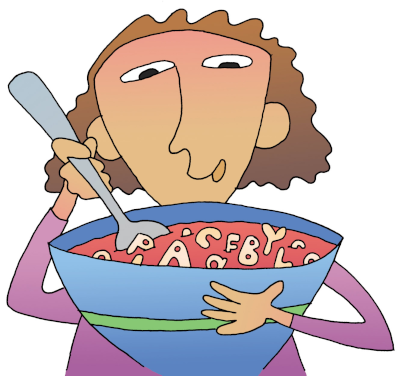Page 359
Becoming a Better Speller

One novelist described his job as putting 26 letters and 12 punctuation marks in an order that makes people laugh and cry and wish for more. In the right order, those individual characters create wonderful meaning.
That's why spelling is so important. A spelling mistake might confuse a reader—and embarrass you.
You can improve your spelling with some simple strategies and a little effort. The following pages show how.
What’s Ahead
WE 360
Page 360
1. Design a personal spelling dictionary.
- Get a notebook or create a file on your computer.
- List the letters of the alphabet, one per page.
- Then each time you have to look up a word or your spell checker corrects it, write the word and its meaning under the correct letter in your spelling dictionary.
- Use this dictionary as your own personalized reference tool.
Sample Personal Dictionary
A
alligator - (remember the two “ll’s”) reptile
afford - to be able to do something or pay for something without bad consequences
askew - something that is out of line or uneven
amendment - an official change to the Constitution
B
byte - computer memory (kilobyte, megabyte, gigabyte)
breeze - (use “z” not “s”) wind
bleacher - flat bench for sitting at sporting events
C
calf - baby cow
choir - singing group
congruent - math term for numbers that agree
confrontation - a face-to-face disagreement
WE 361
Page 361
2. Analyze words using “The 7 Steps.”
- Look at the word and say it aloud. (imperfection)
- Write the word and say it slowly—syllable by syllable. (im/per/fec/tion)
- Study the word for “meaning units,” which would include prefixes, suffixes, base words, and roots: (Im means not, perfect is the base word, and tion means state of.)
- Find the base word or word root and say it slowly. (per/fect)
- Listen for the number of sounds you hear in each syllable versus the number of letters. If the numbers are different, figure out why. Double consonants? Silent letters?
- Say the word again, syllable by syllable, and write it without looking at it. (imperfection)
- Check to make sure you have spelled the word correctly.
Tip Using “The 7 Steps” can obviously help you with your spelling, but it can also help you with the pronunciation and meaning of a word as well. That makes it well worth using.
3. Use word families.
You can spell some words more easily when you place the words in their families. Note how the difficult LETTERS in the first words below are easy to hear and spell in the second words.
To spell . . . |
Relate it to . . . |
Listen for . . . |
|
muSCle |
muSCular |
the S and C sounds |
|
expreSSion |
expreSS |
the SS sound |
|
compEtition |
compEte |
the E sound |
|
gEnetic |
gEne |
the E sound |
|
resIGN |
resIGNation |
the I, G, and N sounds |
WE 362
Page 362
4. Learn to proofread for spelling.
After you have revised your writing, you should check it for punctuation, grammar, and spelling errors. (We recommend that you check your spelling last.) Here are some suggestions.
Read from Bottom to Top 🟪 Start with the last line of your draft and read from bottom to top. This will force you to concentrate on each individual word.
Tip Hold an index card or a half sheet of paper right beneath the line you are studying. After checking one line, move the index card up and check the next line.
Correct the Misspellings 🟪 Cross out each misspelled word and make the correction above it. (Remember: Skip every other line when you write your draft; it will be much easier to make corrections.)
Circle the Puzzlers 🟪 If you are not sure about a spelling, circle it. Double-check the circled words when you have finished checking your entire document.
Use a Spell Checker 🟪 When you write with a computer, you may use a spell checker. Just remember that a spell checker can’t replace a human proofreader. It can’t tell you how to spell a name, and it sometimes misses when you use the wrong word (for example, by instead of buy).
Ask for Help 🟪 Finally, have a friend or classmate check your corrections and look for other spelling errors in your writing.
Note
For more help, check out the following pages:
- Checking Your Spelling (pages 452–455)
- Possessives and Plurals (pages 439, 448–449)
- Using the Right Word (pages 456–465)
WE 363
Page 363
5. Learn some basic spelling rules.
You can avoid some spelling errors by learning a few basic rules. As you will see, most of these rules deal with adding endings to words.
Words Ending in Y 🟪 When you write the plurals of words that end in y, change the y to i and add es.
bully, bullies
country, countries
Except: If the word ends in a vowel plus y, just add s.
boy, boys
monkey, monkeys
Consonant Ending 🟪 When a one-syllable word with a short vowel needs the ending ed, er, or ing, the final consonant is usually doubled.
bat, batted
drop, dropper
get, getting
I Before E 🟪 For words spelled with i and e together, repeat this: “i before e, except after c, or when rhyming with say, as in neighbor and weigh.”
believe, receive, sleigh
Except: Here are some exceptions:
either, neither, their, height, weird, and seize
Silent E 🟪 If a word ends with a silent e, drop the e before adding an ending (suffix) that begins with a vowel.
use, using, usable
believe, believing, believable
Except: Do not drop the e when the suffix begins with a consonant (-ful, -ty, -teen)
nine, ninety, nineteen